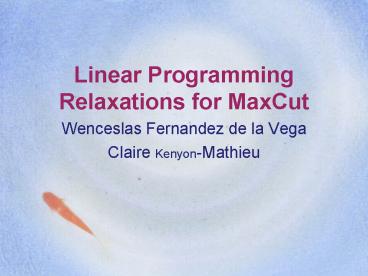Linear Programming Relaxations for MaxCut - PowerPoint PPT Presentation
1 / 22
Title:
Linear Programming Relaxations for MaxCut
Description:
Linear Programming Relaxations for MaxCut. Wenceslas ... IP formulation with 0-1 variables. LP relaxation algorithm. Strengthen LP: add valid inequalities ... – PowerPoint PPT presentation
Number of Views:65
Avg rating:3.0/5.0
Title: Linear Programming Relaxations for MaxCut
1
Linear Programming Relaxations for MaxCut
- Wenceslas Fernandez de la Vega
- Claire Kenyon-Mathieu
2
Technique for approximation
- IP formulation with 0-1 variables
- LP relaxation ? algorithm
- Strengthen LP add valid inequalities
- Reduce integrality gap
- ? Better approximation
3
Example Min Cost Perfect (non-bipartite) Matching
- Unbounded gap LP
- Edge e is taken with probability x(e)
- Every vertex has exactly one adjacent edge
- Edmonds 1965 Reduce gap to 1 by adding
- Every odd vertex set has at least one edge to the
outside
outside
4
Lift and Project (LP)
- BCC, LS, SA, L
- Systematic way to strengthen LPs. Rounds
- After 0 rounds basic LP
- After k rounds contains all valid inequalities
with support k - After n rounds IP
- Poly-time solvable for any fixed k.
5
LP and int gaps
- Vertex cover KG98,AB,L02,C02STT06
- Max 3 SAT, Set cover, Hypergraph vertex cover
BOGH03,AAT05 - Here Maxcut
- Because Theory people like Maxcut!
6
LP for MaxCut
- LP relaxation has gap2 PT94
- Thm here gap is still 2 even after log(n)c
rounds of Sherali-Adams LP - Thm STT (for another LP) gap is still 2 even
after a linear number of rounds of
Lovasz-Shrijver LP. - The moral for MaxCut, SDP is better than LP,
even if the LPs are greatly enhanced.
7
Questions
- Definition of LP?
- Differences Lovasz-Shrijver vs. Sherali-Adams vs.
others? - SDP variant of LP?
- Compare proof to other lower bound proofs for
LP? - No answers in this talk.
8
What I like about this work
- Not the result somewhat unsurprising
- Not the broader impacts
- The proof Relatively clean few short
calculations, all driven by intuition - Next some key ideas for a simple case
- No need to know about lift and project!
9
MaxCut LP relaxation
- x(i,j) indicates whether i,j crosses the cut
- x(i,j)x(j,k)x(k,i) 2
- x(i,j) x(j,k)x(k,i)
- Gap 2
i
j
k
10
enhanced
- Additional valid inequalities
- x(a,b)x(a,c)x(d,e) 6
- We will prove that we still have Gap 2.
d
a
e
b
I cut at most 6 edges
c
11
- Graph sparse random, altered for large girth.
- MaxCut E/2 w.h.p.
- To define x(i,j) threshold T.
- if distance gt T then x(i,j)1/2
- else, construct a random labeling on the
shortest path, and let x(i,j)Pr(labels differ). - Such that x(i,j)1-? for i and j adjacent
- ? FRAC E
Gap2!
12
Core of proof feasibility
- (x(i,j)) satisfies every constraint let S be the
vertices involved in ax-b?0. - Define a distribution over labels of S only, and
let y(i,j)Pr(labels differ). - y is a fractional cut, and constraint is valid
inequality, so by definition ay-b 0 no
calculations needed for this! - Observe that y(i,j) x(i,j)
- Thus ax-b ay-b 0.
13
Defining x(i,j)
14
Defining y(i,j) when Si,j,k,u,v
15
Coupling x(i,j) and y(i,j)
16
Positive results
- Without SDP, is LP actually useful?
- Thm here in dense graphs, gap1 after O(1)
rounds of Sherali-Adams LP - Note this is not surprising since there already
exist at least 3 PTAS for MaxCut in dense graphs.
17
Conclusion
- LP is potentially an attractive alternative to
ad hoc fumbling with existing LPs - Unfortunately, most results so far are negative
if we dont use SDP. - To justify continued work on LP, we need some
positive results for some problem, find a new,
better approximation algorithm by using LP
explicitly and voluntarily.
18
Thats it
- The end
19
Makespan minimization
- Independent jobs, m parallel machines
- LP x(i,j) indicates whether job j goes on
machine i, and tmakespan. - Constraints
- Every job must go on some machine
- Makespan greater than load on each machine
- Unbounded gap
- Add makespanp(j) for every job reduces gap to
2, but this does not appear in LP until after m
rounds.
20
Proof(1/1) based on AFKK
21
(No Transcript)
22
Proof(4/4)
- Given S set of 5 vertices or less, define
(y(i,j)) over cuts of S - Subgraph H(S)edges on some i-to-j path with i,j
in S and distance lt T - Large girth ? H(S) is a forest
- Remove each edge of H(S) w.p. 2? independently
- In each connected component, label vertices
alternating 1 and 0 from a random starting point - Set Y(i,j)1 iff i and j have different labels.
- set y(i,j)Expectation of Y(i,j).































